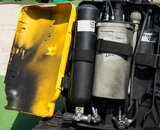MattK911
Contributor
I have been using Atomic B2's (which have titanium air barrels in the 2nd stages) on all my stage/deco regulators for years, and know many people who have done so for decades. None of us have ever had any problems. That being said I wouldn't want to condone it, for fear of inheriting liability. I would personally dive titanium 2nd stages on any mix, though I can't say the same about titanium 1st stages.
All that being said, you're bound to collect more regulators at some point if you stick with it long enough. If you are concerned, use it as an excuse to collect more gear
All that being said, you're bound to collect more regulators at some point if you stick with it long enough. If you are concerned, use it as an excuse to collect more gear






